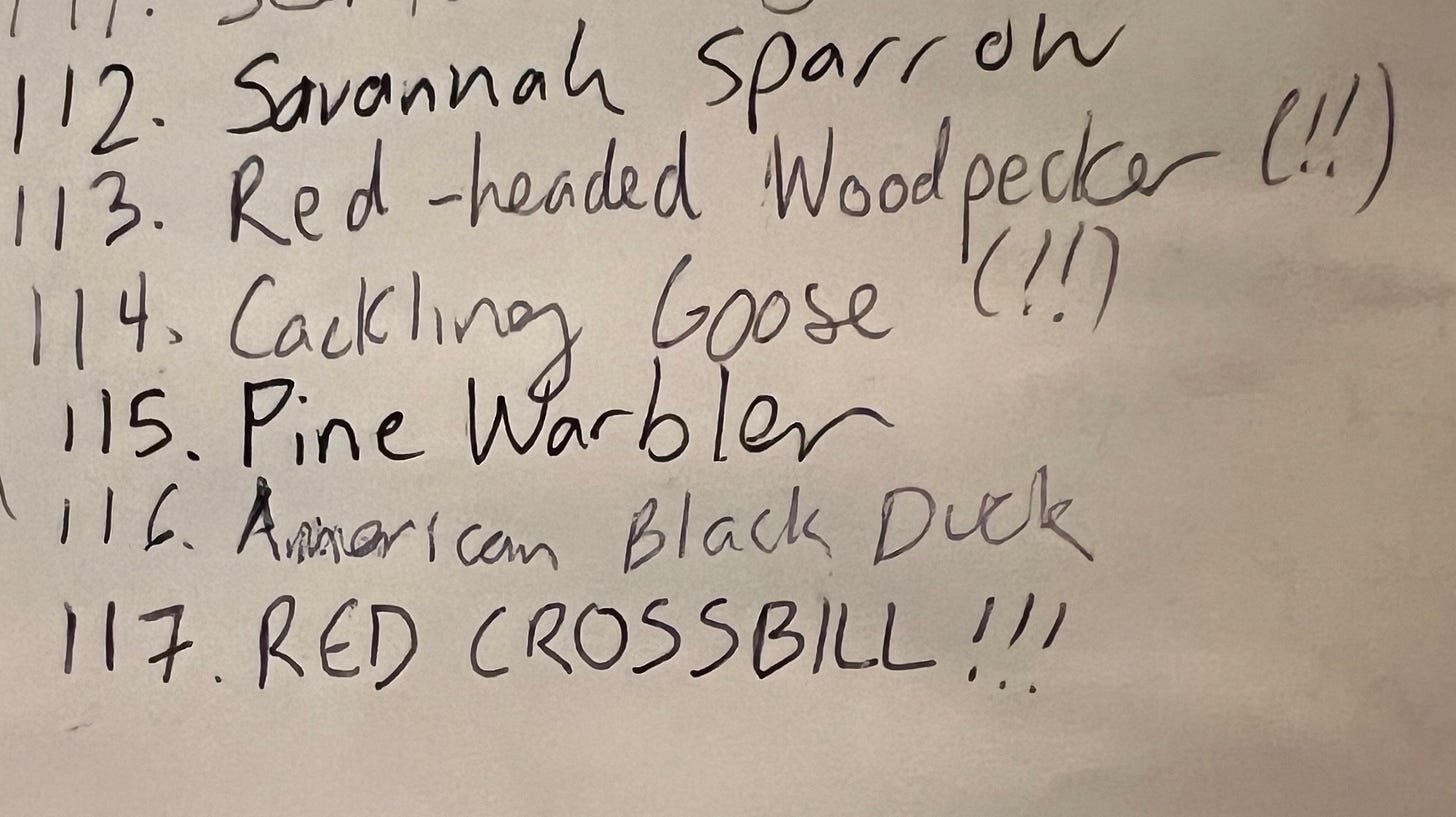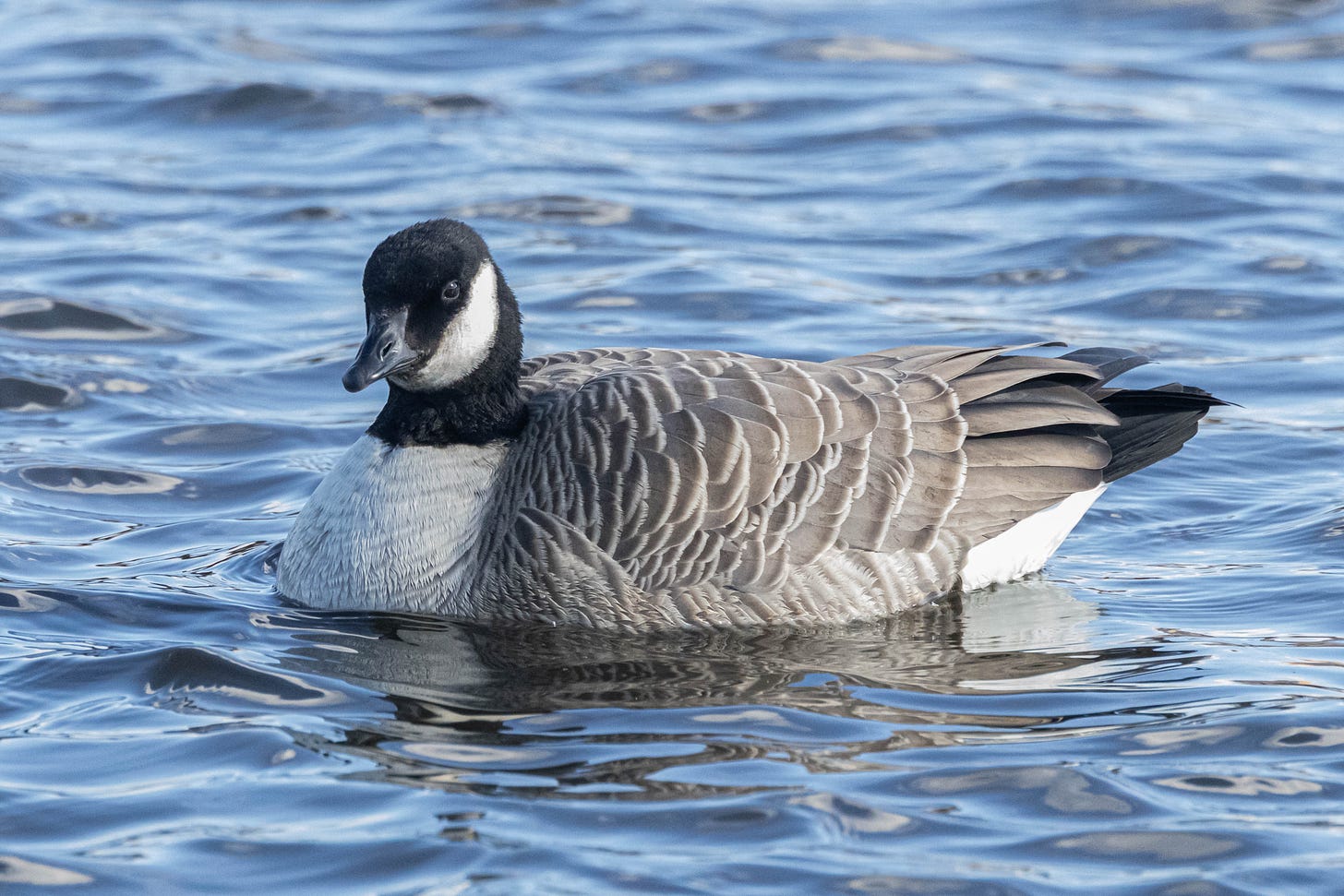my favorite bird flew over my house
i wasnt gonna do a post about this but i couldnt resist
my favorite bird is the red crossbill. it is a brick-red (male) or gray-yellow (female) finch whose beak tips cross like a pair of forceps, and it lives in conifer forests. i do not live near a conifer forest — at least, not near a conifer forest where you can regularly find crossbills. but i had a hunch that this autumn, if i stood on my brooklyn roof enough days in a row, i’d encounter a crossbill flying over. and on tuesday, november 29th 2022, i did.
i could probably write 10,000 words about red crossbills and i will certainly post about them again. so i’ll just focus on my personal evolution into a “loxiaphile,” loxia being the genus name for crossbills. sorry to those of you who have now heard me talk about my rooftop crossbills five times already and wish i would stop. this is the last time!
anyway, back when i was starting to like birds, i stumbled across the wikipedia article for red crossbills. i decided that they looked a lot like my favorite homestar runner character, homsar, thanks to their underbite, lack of a neck, and expressionless face. i decided that i loved them.

the more i read about them, the weirder they got. their beaks are crossed so they can pry open the scales of pine cones and use their tongue to yoink the seed from inside. they’re divided into different “call types,” discernible mainly by close analysis of the “cheep cheep cheep” calls they make in flight, with different beak sizes seemingly tailored for different key conifer species. some of those types could be species on their own. they can breed in almost any month of the year provided they find enough food. and sometimes, they randomly invade new areas looking for cones.
also, they come with literally centuries of lore, despite the fact that today, few non-birders know anything about them. there’s an old german poem, translated by henry wadsworth longfellow, that attributes the bird’s red color and crossed bill to its… trying to pull the nails out of jesus when he was on the cross and getting covered in blood??? and one notable irruption of crossbills into england made it into the drawings of 13th-century english chronicler matthew paris.
as i grew as a birder, i realized that crossbills weren’t quite as mythical as i thought. they’re common in the west, and there’s plenty of good habitat for them in upsatate new york. soon i learned that, with patience and luck, i could see them even in new york city.
crossbill movements are erratic, but they’re not totally unpredictable. as i’ve explained in a few other posts, lots of the birds we see in new york city follow some sort of fluctuating pattern based on how much food is available in the surrounding forests. crossbills are among the most well-known examples of this phenomenon. these birds follow the cones, and in years where there aren’t cones, they move. there’s an annual finch forecast you can follow that predicts the movements of crossbills and other northern finches based on the amount of available food in the boreal forests.
given all that, plus new york city’s well-known tendency to trap migrating birds, crossbills actually show up in the city with some regularity. in fact, the pine barrens of long island and new jersey form part of the “primary zone of irruption” for the red crossbills that inhabit the northeast’s conifer forests—if they run out of food in the boreal forest, they know to check the coastal pitch pines first. in the city where there aren’t conifer forests, you might find crossbills in the planted pines and spruces at various greenspaces, but more likely you’ll just hear them “cheep cheep cheep”-ing while they move overhead. that’s how i saw my first crossbills in 2018, migrating westward along the outer barrier of long island.
crossbills showed up again in 2020, taking the city by force. many birders encountered the finches in their local parks, and a large flock spent several months hanging around the japanese black pines of floyd bennett field. some birders even saw crossbills from their apartments. this year, after spending dozens of days on my roof watching all sorts of common and rare birds migrate over, i figured that i could get red crossbill on my apartment list, too.

i bared two weeks of frigid november mornings on the roof with few birds moving at all, motivated only by reports in the surrounding area. despite the misses, i only got more sure that i’d get my rooftop crossbills. other birders began reporting them in prospect park and green-wood cemetery, and i encountered one while leading a walk at jamaica bay wildlife refuge.
but november 29th felt different. i was totally convinced it would be the day. robins, geese, goldfinches, and cedar waxwings were moving overhead in small numbers. and then at 9am, i heard them: a distant chorus of “cheep cheep cheep!“ I made sure my voice recorder app was ready, and the group of birds headed directly overhead. i didn’t get a photo, but i didn’t have to. unless they’re up close, a recording tells way more of a crossbill’s story than a photo can.

the number one lesson i’ve learned from birding on my roof is that the city’s parks don’t have some sort of force field around them. the entire city is wildlife habitat. any bird you encounter in the parks you might also encounter on the sidewalk, in street trees, or flying overhead. even rare northern finches. actually, there are certain birds i’m more likely to encounter flying over my apartment than in the nearby parks, like dickcissels, american pipits, and bobolinks. i’ve seen more opossums on the sidewalk than in the park, and i’ve seen moths on my roof that make other moth-watchers jealous.
of course, that means that even outside of the parks, we have to think about how our actions affect wildlife. you know, bird safe glass, keeping cats inside, the whole thing. the only difference between a natural area and an unnatural area is how you treat it.
postscript
i meant to tell you: i was on science friday last week! you can listen to me and ira banter and talk to guests about birds for a half hour here.
finally, i’m going to north dakota tomorrow so i’ll probably be lax on the newsletter for the rest of the year. here’s a goose.





